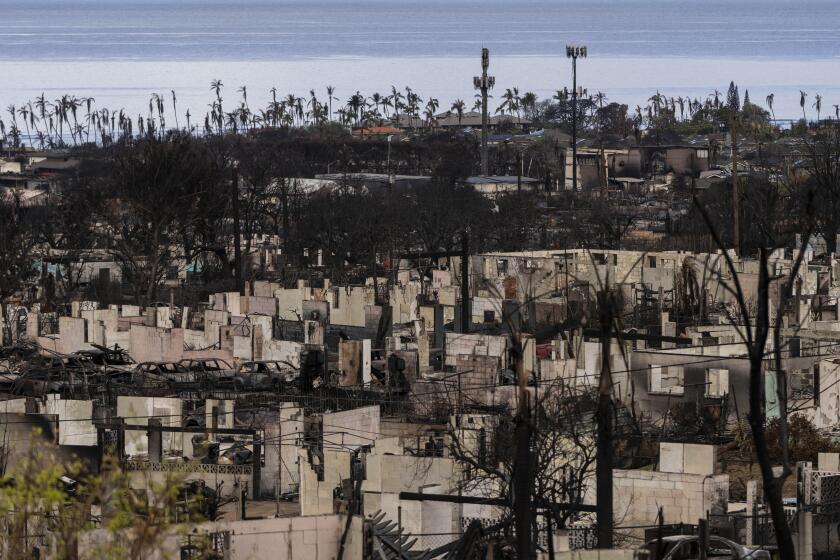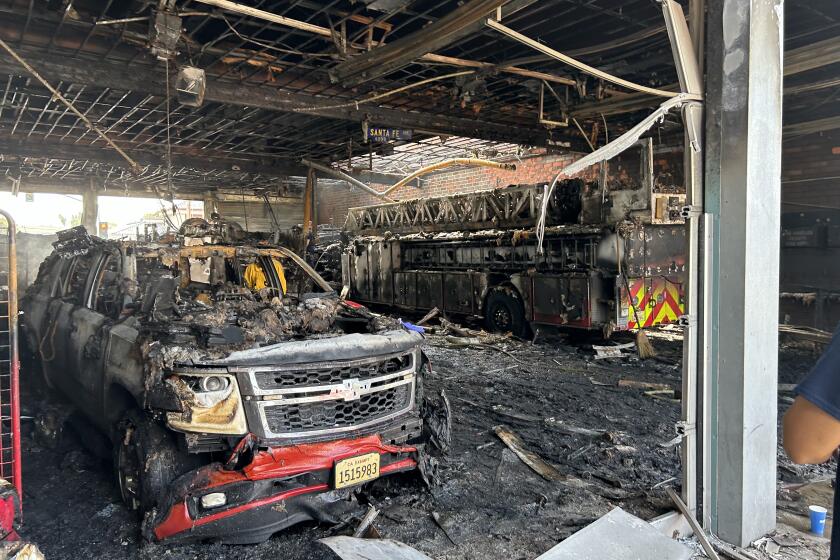Book Prepares Topangans for the Wildfire Next Time
In the old days they would stay and fight.
Crusty, independent-minded inhabitants of Topanga Canyon filled barrels with water and laid out garden hoses when brush fires swept toward their scattered mountain cottages and creek-side counterculture enclaves.
As recently as five years ago, canyon leaders mass-mailed a safety brochure to residents suggesting that the able-bodied not flee but remain home and be ready to snuff out embers once the fire front passed.
But the old-timers are fading away. And beginning today, a generation that has moved from the city into the canyon is getting new marching orders.
They come in a 147-page Los Angeles County information guide that is part emergency-preparedness handbook and part oral history.
“The Topanga Disaster Survival Guide” is filled with photographs and personal stories of canyon dwellers who have lived through fires and floods and are prepared for the next onslaught.
The county is spending $40,000 to mail two copies of the slick, spiral-bound book to each of the 2,900 families who live in the rugged Santa Monica Mountains area between Malibu and the San Fernando Valley.
The book is geared to newcomers who have never experienced a wildfire (it’s been 12 years since Topanga last burned). But it also deals with such canyon threats as flooding, landslides, earthquakes -- even rattlesnake bites.
“It’s not dry. It’s not overwhelming. It’s user-friendly,” said Susan Nissman, a 30-year canyon resident and an aide to county Supervisor Zev Yaroslavsky, who represents the area.
“There’s been a major change in demographics in the canyon. Old-timers who knew about brush fires are gone. New people don’t know. Somebody moving in from the city to this wild region may not have any idea something like this could happen.”
The book in as colorful as Topanga’s residents.
In a fold-out picture section, costumed Shakespearean actors Willow Geer, Miko Sperber and Karen Reed from the canyon’s Theatricum Botanicum demonstrate first-aid procedures.
Burn victim Ron Mass tells of his 1993 brush with death while trying to drive through the fire that swept past Old Topanga Canyon Road on its way from Calabasas to the sea. “Cars can’t drive through fire like they do in the movies.... My ignition wires melted and my tires exploded.”
Jane Marla Robbins recounts how she coped after escaping her burning bungalow near Topanga State Park five years ago. “I had my car and a bathrobe. That was it. And from the top of the driveway above the house, along with 25 of my closest neighbors, I watched the house burn.”
Fernwood neighborhood resident Alli Acker, a lifelong canyon resident, is photographed with the goggles, fire jacket, respirator, emergency blanket and other equipment she keeps in her home disaster kit.
Others explain how horses should be cared for as brush fires move in, how various canyon neighborhoods should move to predesignated “safe” areas and how each corner of the canyon has its own emergency frequency designated for the public-use Family Radio Service. “Cellphones might be useless” because of power outages during emergencies, the book points out.
County officials hope that the guide’s personal approach will entice residents to actually read it.
The Topanga book is being viewed by county officials as the prototype for disaster guides in other unincorporated communities, Nissman said.
Under that proposal, each guide would also feature local residents and focus on local issues, such as the danger from chemical plants in urban areas and flooding in low-lying zones. Hilly communities and those at the edge of mountains would receive emergency information about landslides and wildfires.
Officials selected Topanga for the initial guide after deciding the canyon was the most disaster-prone unincorporated area in the county. Topanga also has an emergency-preparedness team that was created shortly before the 1993 fire.
The Topanga Coalition for Emergency Preparedness joined with county representatives and other public agencies during the two years it took to produce the book. Early on, everyone agreed that staying and fighting was no longer a safe option in the canyon, which is now home to about 13,000 people.
“You don’t see any recommendation of staying in the book,” said Pat MacNeil, the coalition’s head. “That’s a last resort. Topanga has changed. A great many of the people here do not know how to deal with fire. They come out from the city because the place is pretty, but they don’t realize the sheriff and Fire Department may not be able to get to them.”
The book’s timing is right too, said MacNeil, who has lived 27 years on a one-acre canyon hilltop.
“The fires last week, and [hurricanes] Katrina and Rita, I think those have really opened people’s eyes that they really need to be able to take care of themselves,” she said.
Bill Buerge, the guide’s designer, said he had no difficulty recruiting for the book people who had been through previous canyon calamities. Neighbors Kedric Wolfe, an actor, and Robin Spehar, a street performer, were used as models to pictorially link the book’s chapters.
“Government publications can be deadly, very dry,” said Buerge, an artist, preservationist and 25-year canyon resident. “I wanted to do the survival stories people could relate to. I wanted lots of Topangans in the book. When this book arrives and you open it up, here’s somebody you know, and it really hits home.”
He said the photos and maps designating “neighborhood survival areas” throughout the canyon could be lifesavers for residents unable to evacuate in advance of a wildfire.
That could happen in a wind-driven conflagration, said county Assistant Fire Chief Reggie Lee, who oversees the area.
“It would take four hours to get 12,000 to 15,000 people out of the canyon,” he said Thursday. “In a worst-case scenario, the fire would have burned through in two hours.”
One plan not covered in the book is a proposal to turn both lanes of Topanga Canyon Boulevard into a southbound evacuation route. As residents fled toward the ocean, firetrucks responding to Topanga would enter the canyon from the northern Valley side, he said.
These days, said Lee, Topangans should be prepared to go, not stay.
More to Read
Start your day right
Sign up for Essential California for news, features and recommendations from the L.A. Times and beyond in your inbox six days a week.
You may occasionally receive promotional content from the Los Angeles Times.







